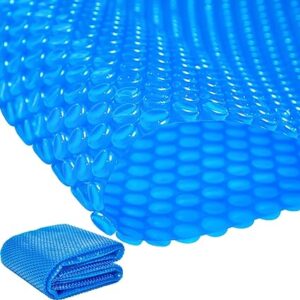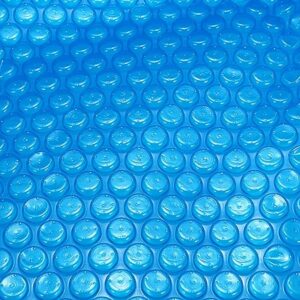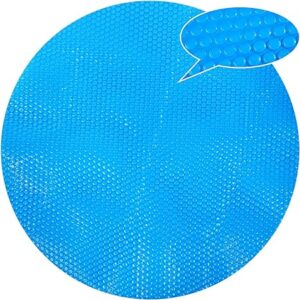The Ultimate Guide to Pool Solar Covers: Reels, Inground Options, and More!

Opening your pool for summer is an exciting time after the winter months. However maintaining proper water temperature, chemicals, and cleanliness quickly becomes a chore. Installing a pool solar cover makes pool care easy while maximizing your enjoyment.
Solar covers act as blankets for your pool, harnessing heat from the sun to naturally warm the water. They provide additional benefits that create the ideal summer oasis in your backyard.
| Disclosure: We use affiliate links in our content. This won’t cost you anything but as Amazon affiliates, we earn from qualifying purchases to help offset the cost of paying our writing team. |

In this article, we dive into the many advantages solar covers offer.
- Heating – They use free solar energy to heat your pool water.
- Water Conservation – They prevent evaporation and conserve hundreds of gallons of water.
- Debris Protection – They keep out leaves, pollen, and other clutter.
- Extended Season – Enjoy your pool weeks longer on both ends of summer.
We also cover the different types of covers, factors to consider when buying, and proper installation. With a quality solar cover, you’ll spend less time on chemicals and heating, and more time relaxing poolside. Read on to learn how solar covers save time, money, and water for more fun in the sun!
The Many Benefits of Pool Solar Covers

Installing a cover on your in-ground or above-ground pool provides numerous benefits in terms of pool maintenance and enjoyment.
Heat the Water
- Covers are engineered to absorb up to 70% of sunlight and transfer that heat directly to your pool water.
- This can raise your water temperature by 8-10°F compared to an uncovered pool. That’s like turning your pool into a free natural hot tub!
- The extra heat extends your swimming season by allowing you to open your pool earlier in the spring and keep it open weeks longer into the fall.
- With a cover, you can gain up to 4 more months of swimming each year. Open your pool 2-3 weeks earlier and close it 2-3 weeks later.
Reduce Heating Cost Significantly

- The cover will retain heat which means serious savings on your energy bills.
- Covers can cut your pool heating bill by 30-70% since less energy is required from your pool heater.
- For an average-sized pool, you can save $100-$200 per month and hundreds of dollars over the entire season on electricity or gas costs.
- With optimal conditions, a cover can completely pay for itself in energy savings in only 1-2 seasons.
- That’s money you could spend on pool toys, accessories, or improvements instead of pumping it into your utility bills.
Minimize Water Evaporation

- Evaporation is the invisible water thief that gradually depletes your pool over time.
- A cover forms a protective physical barrier that prevents up to 95% of evaporative water loss.
- This can conserve thousands of gallons of water each season compared to an uncovered pool.
- Less evaporation means you’ll spend less time constantly refilling your pool throughout the season. This saves you money.
- Reduced water replenishment also means less chlorine and other chemicals will be needed.
Keep out Debris and Prevent Algae

- When floating atop the pool, covers block outside contaminants like dust, pollen, leaves, and insects from settling into your water.
- This keeps your pool cleaner and clearer in between skimming. You’ll spend less time fishing out debris.
- It also deprives algae of the sunlight it needs to grow and spread. Algae can’t proliferate under the cover.
- Your cover goes to work 24/7 protecting your pool even when you’re not swimming. It’s like an automatic pool housekeeper.
Prolong Chemical Balance

- By preventing up to 95% of evaporative water loss, covers maintain proper chemical levels for longer.
- Less water evaporation means chlorine, pH, and other chemicals do not get depleted as quickly.
- Fewer chemical additions are needed weekly, saving you time and money.
- The stable water conditions inhibit algae growth which also throws off chemical balance.
Extend Pool Season

Covers can warm the water enough to open your pool 2-3 weeks earlier in the spring.
The warmer water enables swimming even when the air is still cool in spring and fall.
Pool owners can typically keep their pool open 2-3 weeks later into the fall season as well.
This adds a total of 4-6 extra weeks of usable pool time before.
While air temps may be cooler in spring and fall, the water itself remains comfortably warm enough for swimming.
Covers extend your swimming and enjoyment for more months during the year.
Instead of just 3 months, covers give you up to 6 months of pool time from early spring through fall.
Provide Winter Protection

- Covers can be used instead of tarps or mesh covers to close your pool for winter.
- Their durable plastic sheeting withstands winter weather and prevents contaminants from entering.
- More affordable than custom-fitted winter covers.
- Save on the costs of draining or adding chemicals before closing by using your cover through winter.
- Come spring, uncover a clearer pool that’s ready to open sooner.
Solar Cover Options and Installation

With so many cover choices on the market, it’s important to understand the different types available and the factors that affect performance. Proper installation ensures your cover fits right and can do its job efficiently by heating and protecting your pool.
Types of Covers
The two main categories of covers are bubble and thermal blanket styles:
- Bubble covers have small air-filled plastic bubbles that float on the surface. They trap heat and reduce evaporation.
- Thermal blankets are insulated foams that form a solid floating cover. They’re more durable and effective at heat retention.
- Liquid covers are a thinner liquid-chemical alternative that forms an invisible layer to retain heat.
Thickness and Mil Rating

- Thicker covers between 10-12 mils are ideal for strength, durability, and heat efficiency.
- Very thin covers can tear easily. Overly thick covers are heavy and harder to handle.
- Mid-range thickness offers the best of both – effective heating and easy handling.
Proper Sizing and Custom Made
- Measure your pool carefully to get a cover that fits wall-to-wall.
- Custom-fit covers maximize heating capabilities for any pool size or shape.
- Loose-fitting covers leave gaps for heat loss and evaporation.
Installation Tips

- Roll the cover out over balanced water for smooth flat placement.
- Secure the edges with provided grommets, loops, or anchors.
- Allow sufficient slack so the cover can float freely as the water level changes.
- Use a solar reel system for rolling storage when not needed.
Solar Cover Considerations
Once you’ve installed your cover, a bit of routine care and proper use will ensure you get the most out of its heating and cleaning capabilities. Follow these tips for success:
Handling with Care

- Inspect weekly and remove debris to prevent tears or punctures.
- Lift on and off by the grommets, not the plastic itself.
- Avoid dragging sharp objects like cleaning tools across the cover.
- Use a cover reel for quick roll-up when cleaning the pool.
Maximizing Heat Retention
- Leave cover on overnight and at least 12 hours per day for best heating.
- Take out cover for 1-2 hours midday when the sun is strongest to absorb more heat.
- When done swimming, put it back immediately to retain warmth.
Preventing Accidents and Contamination

- No cover should be in the water when the pool is in use to avoid entrapment.
- Check and adjust chemical levels regularly to keep the water balanced.
- Shock treatment as needed to maintain proper sanitation.
- Clean cover periodically for maximum light absorption.
With smart use and care, your cover will maintain your pool’s warmth and cleanliness for many seasons. Be sure to inspect it at least twice a year for wear and deterioration.
Conclusion

Let’s be honest – opening up your pool is super exciting, but keeping it sparkling clean and warm enough to use can quickly become a headache. Between balancing chemicals, scooping out leaves, and turning on the heater, you might spend more time as a pool maintenance worker than actually swimming in it. That’s why installing a solar pool cover could be a total game-changer for your pool.

Frequently Asked Questions
Q: How does solar pool cover work?
A: Covers use passive heating to capture warmth from sunlight. They float on the surface to retain heat that would normally escape from the water.
Q: What are the main benefits of a cover?
A: The main benefits are heating the water using free solar energy, reducing cost, minimizing water evaporation, blocking debris/contaminants, inhibiting algae growth, and prolonging the pool season.
Q: What increase can I expect with a cover?
A: On sunny days, covers can increase pool water temperature by 8-10°F. In general, expect an increase of 5-8°F.
Q: How much can I save on heat with a cover?
A: Savings vary based on pool size, climate, and current utility cost. Most pools save 30-70% on utilities by using passive solar heating.
Q: What is a solar pool cover made of?
A: Most are from polymer plastics like polyethylene or polypropylene bubbles or foam sheeting. They contain UV inhibitors that protect against sun damage.
Q: How long does a solar pool cover last?
A: With proper maintenance, covers typically last 4-6 seasons. Inspect regularly for wear and punctures. Replace if the material becomes brittle or damaged.
Q: How do I maintain and store my cover?
A: When not in use, roll up the cover and keep it out of direct sunlight. Inspect often and clean as needed. Use a reel system for simple handling.




Comments
[…] time and energy spent on pool maintenance this summer by getting the right rake for the task at hand. Your water stays inviting all year so […]